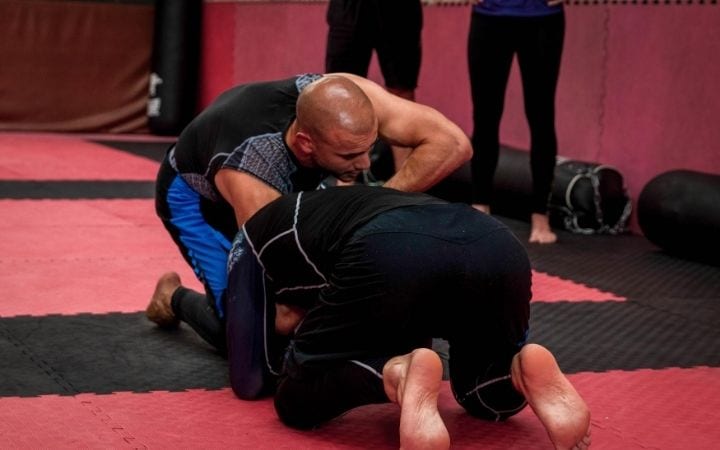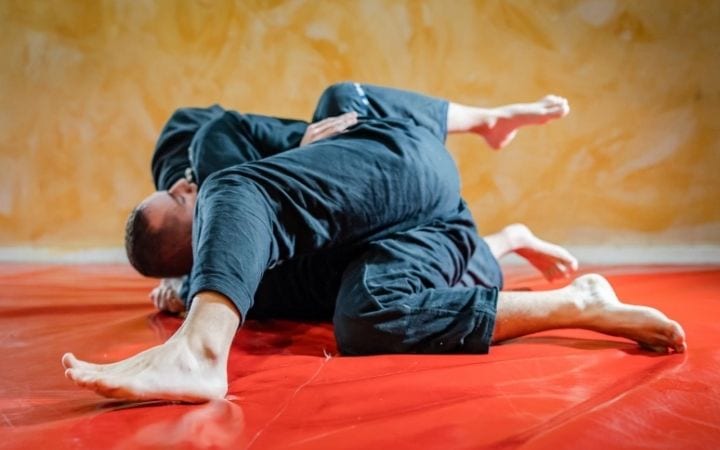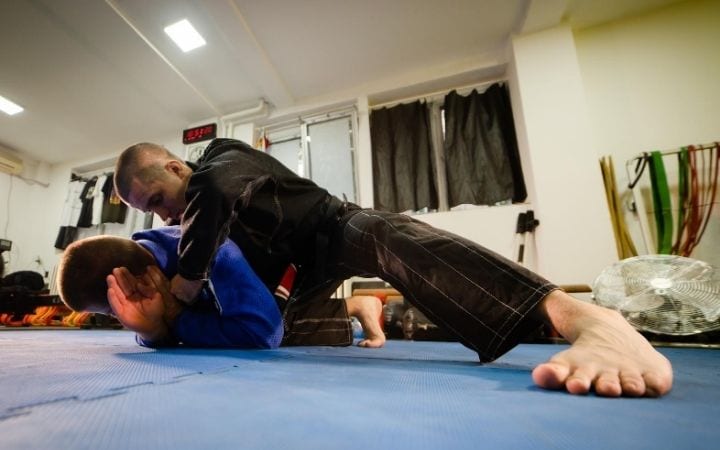The crucifix in Jiu Jitsu is a versatile technique that provides its users a wide range of attacks stemming from the same position. The position is alluring due to its ability to completely trap both of your opponent’s arms.
In Jiu Jitsu, there is an array of submissions available from the crucifix. However, the position is even more devastating in MMA, with your opponent’s head left completely unguarded and vulnerable to punches and elbows.
While its name gives it an intimidating air, you might find the crucifix position more accessible if you think of it as a type of guard or back mount variant. We can think of a guard as being any position that, in and of itself, is not deadly, but will both lockdown an opponent while also providing several options for tactical advancement.
While there are many submissions available from the crucifix position, you will want to work on your limb dexterity and flexibility to maximize their potential. Let’s examine a few ways you can enter into, submit, and escape from the crucifix position.

Crucifix Entries
Turtle
Perhaps the most common crucifix entry is from attacking your opponent’s turtle position. Your main priority for entry into the crucifix will be opening up the turtle and isolating your opponent’s arms.
Let’s assume your opponent shot for a double leg takedown. The best-case scenario plays out and you sprawl hard onto your opponent, forcing them to their knees. If they continue to drive to salvage the takedown attempt, they will likely retract their elbows tight to their hips for a tight turtle position.
While you are still in a full sprawl with chest pressure on their back, circle to one side, pressing your close knee into whatever opening is available. For added pressure, post off of your outside foot. To lock yourself to your opponent, weave your close arm under their far arm and grab hold of their wrist or forearm. This grip will be key to securing the crucifix.
It may not be easy to insert your knee between your opponent’s elbow and hip. Try starting a little higher on their body with your knee and slide down, wedging their elbow from their hip. Once your knee is sunken into their side, you are going to drive that knee forward by sliding onto your hip. This motion will flair their same side arm out, leaving it exposed.
Once exposed, it will be up to your far leg to gather the arm. Touch your outside heel to your inside knee, essentially forming a loop around the exposed arm. Use your heel to collect the arm and lock it in place with a leg figure-four.
With both arms locked, roll over your inside shoulder (i.e. the shoulder closest to your opponent’s hips). You will essentially “flip the turtle onto its shell”, and have a locked-in crucifix and very vulnerable opponent.
As a tip, many wrestlers, in an attempt to salvage a takedown, will attempt to collect your far leg and arm to drive you onto your side. They will essentially put themselves into the crucifix setup. It is now your job to roll over the inside shoulder before you are dumped onto your side!
Side Control Setup
This particular entry is slightly unorthodox and it hides in plain sight. In this case, you will enter the crucifix from top side control. As with the turtle entry, you will have to begin your set up in one position, and then drastically change the position to end in a proper crucifix.
In the top side entry, you will start out placing the crucifix backward. To do so, place an underhook on the far arm. Next, slide your hips toward your opponent’s head and place their inside arm between your legs.
Once you’ve collected both arms, figure-four the inside arm to lock it in place. Now, fall to your side so that you’ll land on the mat with your stomach touching the top of your opponent’s head.
Try to generate momentum as you do this, because you will have to bring your opponent with you. As you fall, use your inside hand (the hand that is closest to your opponent’s hips while you are on top side) to yank your opponent’s shoulder up and toward you. This will help lift them onto you slightly, landing you in a more typical crucifix position.

Submissions
Lapel Choke
Assuming you are rolling the gi, a basic lapel choke will be a simple, yet effective finish from the crucifix. Fortunately, there is no need to maneuver your legs and arm that are already occupied controlling your opponent’s arms.
For added control of the top arm (your opponent’s arm that is controlled by your own arm) you can either grab your cross lapel or reach for the back of your head while looped around their arm.
This should be sufficient control for you to free up your outside arm to attack a lapel choke. Reach under your opponent’s head and loop your hand around their neck to grasp the lapel closest to you. Insert your thumb into the collar and grip the lapel as deeply as you can.
Straighten your arm bringing the lapel against the neck and the choke should be achieved almost instantly. While the choke itself is powerful, your opponent’s inability to defend their neck really elevates this standard gi choke.
Reverse Triangle
The reverse triangle requires more thought and dexterity than the lapel choke, but the control of the crucifix allows you to work fairly freely.
To set up the reverse triangle, you will have to have your outside leg free. Depending on how you positioned your legs to trap your opponent’s far arm, you may need to transfer the arm from one leg to another.
If you have the arm trapped primarily under your outside leg, glide that leg down the arm toward the wrist, making room for your inside leg to take control. Once the inside leg has seized control of the arm, your outside leg should be able to move freely.
Depending on your flexibility, you may find that you need to shrimp away from your opponent slightly for a better angle of attack. Push your opponent’s head away from you with your outside arm. This will make it easier to pass your free leg over the head.
Once the leg is over, abandon the far arm control with your leg in favor of a figure-four around your opponent’s neck. Not all the tenets of a typical triangle will apply in this unorthodox setup. That said, do not worry about bringing your opponent’s arm across their neck to finish the choke. Focus on the figure-four, and the choke will be achieved.
Escapes
Tuck and Roll
If you made the unfortunate error of being caught in the crucifix, there is still hope. A tried and true method of escaping the crucifix position is the tuck and roll. It will require a decent amount of body control, spatial awareness, and hip elevation.
Before you attempt the actual escape, be sure that both of your arms are in the proper position. For reference, both arms should essentially be pointing up, or knuckles facing the direction you want to roll to. Your arm closest to the head should seek out a collar tie on your opponent to establish an anchor point to help pull your body.
More importantly, the arm trapped by your opponent’s legs must be facing up. If not, and you attempt to roll, you risk hurting your arm.
Try to use their top or outside leg as an anchor point. Once your arms are in the proper position, scoot your hips forward and away from your opponent’s body. This motion will sink you to the mat and clear your head from your opponent’s body.
The top of your head should be touching their hip. If you have not cleared your head, you will be blocking yourself from completing the technique.
When in position, elevate your hips, extend your legs, and point your toes behind you. This motion will flip you over your opponent, landing you in top side control. Your arm should end up in a good position, but you will need to remain diligent in clearing your arm from your opponent’s legs.

Summary
Although it may sound scary, the crucifix is a great technique that provides you with many options for attack. The foundation of the crucifix is isolating your opponent’s arms.
After you’ve isolated your opponent’s arms, there are plenty of opportunities for arm locks and chokes. Try setting up the crucifix from different positions such as turtle, or side control, and experiment with the different submissions available to you.
Jeremy is brown belt and has a Bachelor’s degree in journalism, but he also enjoys creative writing. Originally from Connecticut, where he began his 11 years of Jiu Jitsu training.
